Published: May 2023
Contents
- Introduction
- Policy Context
- Belfast Local Development Plan
- Policy Objectives
- Guidance for advertisements and signage
- 5.1 Overview
- 5.2 Poster panel/freestanding displays
- 5.3 Gable mounted advertisements
- 5.4 Shroud advertisements
- 5.5 Commercial/shopfront advertisements
- 5.6 Retail and business park signage
- 5.7 Filling station/forecourt signage
- 5.8 Pylon and pole mounted signage
- 5.9 Digital advertisements
- 5.10 Small format outdoor advertisements
- 5.11 Estate agent boards
- 5.12 Flyposting
- Information required for applications
- Enforcement of advertisement control
- Footnotes
1 Introduction
1.1 Overview
1.1.1 This Supplementary Planning Guidance (SPG) provides advice and guidance specific to the display of advertisements and signage within Belfast, and is intended for use by developers, the public and planning officers in the assessment and delivery of applications for consent to display an advertisement. The guidance applies to proposals for advertisements which include poster panel displays, shroud advertisements, pylon/pole mounted signs as well as signs displayed on commercial premises, retail and business parks and petrol filling stations. Additional types of advertisements include freestanding digital kiosks and large digital signs integral to the building fabric, which have grown in popularity across Belfast over more recent years.
1.2 Purpose of guidance
1.2.1 This SPG represents non-statutory planning guidance that supports, clarifies and/or illustrates by example, policies contained within the current planning policy framework, including development plans and regional planning guidance. The information set out in this SPG should therefore be read in conjunction with the existing planning policy framework, most notably the Strategic Planning Policy Statement (SPPS) for Northern Ireland and the Belfast Local Development Plan.
2 Policy Context
2.1 The Planning Act (Northern Ireland) 2011
2.1.1 Section 130 of The Planning Act (Northern Ireland) 2011 requires the council to make provisions, by regulations, for restricting or regulating the display of advertisements so far as it appears to be expedient in the interests of amenity or public safety. The Planning (Control of Advertisements) Regulations (Northern Ireland) 2015 as amended is the relevant statutory rule (referred to as ‘the Regulations’).
2.1.2 Under the Regulations, some types of advertisement can be exempt from control by the council provided that certain conditions are met[Footnote 1]. Other specified categories of advertisement are deemed to be granted by the Regulations, commonly referred to as ‘deemed consent’, provided they conform to the stated limitations for each category and a schedule of standard conditions[Footnote 2].
Image 1: Deemed Consent
Diagram is a guide as to the kind of advertisements where council can and cannot restrict deemed consent.
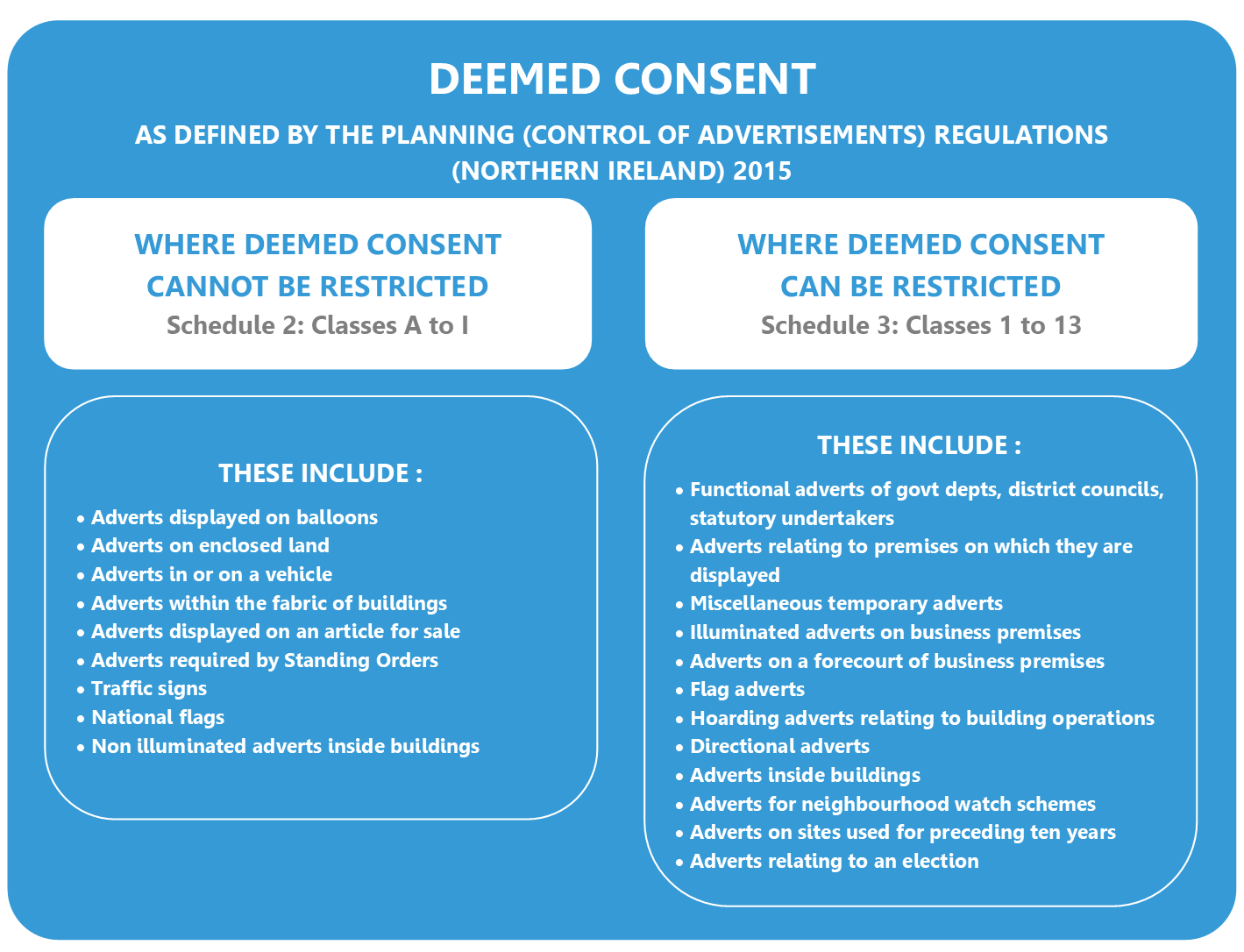
2.1.3 This type of advertisements can be considered to fall into two camps, those where ‘deemed consent’ cannot be restricted, such as small plaques on business premises and non-illuminated advertisements inside buildings, and those where the council may decide to restrict ‘deemed consent’. Cases where ‘deemed consent’ may be restricted by the council could include elements such as estate agent boards, where a proliferation of such items is considered to have an adverse impact on the character and appearance of a conservation area for example. All other advertisements require the council’s express consent, commonly referred as ‘consent to display an advertisement’.
2.1.4 Section 175 of the Planning Act states that it is an offence to display an advertisement in contravention of the Advertisement Regulations. Further information on this matter together with advice on the council’s position regarding the enforcement of advertisement control is set out in Section 7.
2.1.5 The Planning Act defines an advertisement as:
“any word, letter, model, sign, placard, board, notice, awning, blind, device, or representation, whether illuminated or not, in the nature of, and employed wholly or partly for the purposes of, advertisement, announcement or direction, and (without prejudice to the preceding provisions of this definition) includes any hoarding or similar structure used, or designed or adapted for use, and anything else principally used, or designed or adapted principally for use, for the display of advertisements, and references to the display of advertisements shall be constructed accordingly.”
2.2 Regional Development Strategy (RDS) 2035
2.2.1 The RDS provides regional guidance under the three sustainable development themes of economy, society and environment. It seeks to promote employment and support economic development of the region while sustaining a high quality environment. While the role of advertisements is not specifically referred to in the RDS, by its very nature advertising contributes to the creation of a vibrant and competitive economy and as such care must be exercised given the potential significant impact that outdoor advertising can have on the environment.
2.3 Strategic Planning Policy Statement (SPPS) for Northern Ireland (2015)
2.3.1 The SPPS identifies core principles to assist with plan-making and decision taking. It recognises the need to support good design and positive placemaking, that good design contributes to the creation of places to live that are safe and attractive and is a key element in achieving sustainable development.
2.3.2 Under ‘Improving Health and Wellbeing’, the SPPS also recognises that there are a wide range of environment and amenity considerations arising from development that may have potential health and well-being implications, including impacts relating to visual intrusion, general nuisance, loss of light and overshadowing.
2.4 Roads legislation
2.4.1 In addition to planning legislation, there are separate provisions within roads legislation for the control of advertisements. Article 87 of the Roads (Northern Ireland) Order 1993 makes it an offence to display any advertisement on a public road, footway or verge or on any tree or structure in or on a public road. Article 21 of the same Order makes it an offence to erect or exhibit any advertisement or notice sited or designed primarily to be visible from a special road or which is likely to prejudice the safety of traffic using a special road. A special road is one designated under Article 15 of the Roads Order and at present these comprise the motorway network and Westlink.
2.4.2 Article 34 of the Road Traffic Regulation (Northern Ireland) Order 1997 makes it an offence to display any sign which resembles a traffic sign on or near a public road.
3 Belfast Local Development Plan
3.1 Plan Strategy
3.1.1 The Belfast Local Development Plan (LDP) provides the strategic policy framework for the plan area across a range of topics and sets out the vision for Belfast, as well as the objectives and strategic policies required to deliver that vision. It includes a suite of topic-based operational policies, including a policy specifically tailored to advertising and signage.
3.1.2 In exercise of its responsibility for development management within the Belfast area (including advertisement control), the council assesses development proposals against all planning policies and other relevant material considerations. While it is intended that this SPG will supplement, support and underpin policy pertaining to advertising and signage, it is important that the policy is considered in the round alongside other relevant polices contained within the Plan Strategy.
3.1.3 The Plan Strategy includes several overarching strategic policies which are to be used both as a guide to assist in delivering the key aims and objectives of the LDP. The diagram illustrates how policy tailored to advertising and signage can be considered alongside other relevant topic based policies under Strategic Policy SP5 ‘Positive Placemaking’. This SPG should be read in conjunction with other planning policy publications, including the RDS, and regard should also be given to additional SPG that has been published in support of other policies that are deemed relevant.
Image 2: Local Development Plan Policy Context
Diagram illustrates how Policy DES4 Advertising and signage sits below overarching Strategic Policies, in particular SP5 Positive Placemaking, and its consideration alongside a range of accompanying topic based polices within the ‘Shaping a liveable place’ theme as well as other relevant thematic polices.
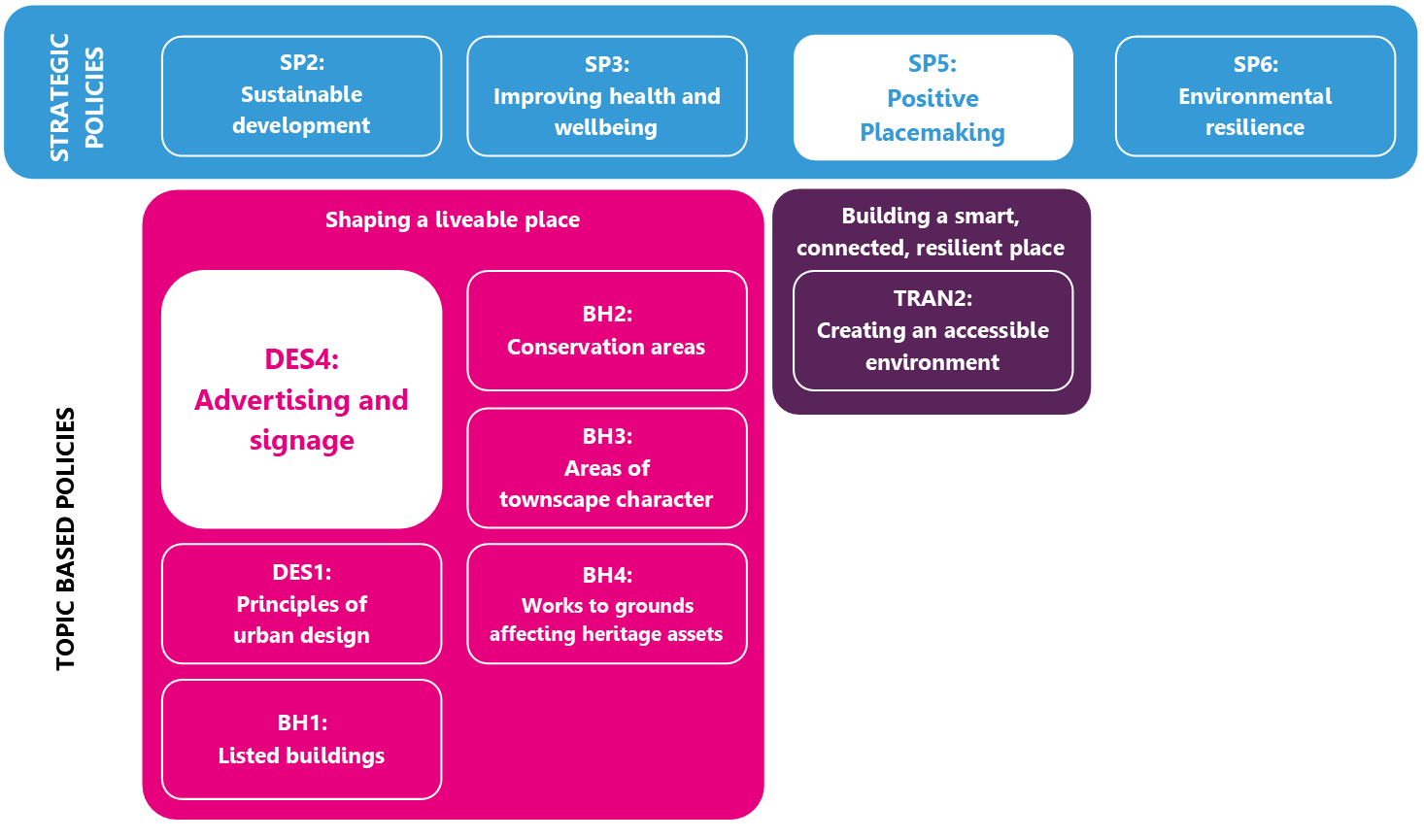
4 Policy Objectives
4.1 Policy DES4 - Advertising and signage
Policy DES4 : Advertising and signage
Planning permission will be granted for advertisements and signage where it has been demonstrated that they:
- Are of good design quality, are located sensitively within the streetscape and do not have a negative impact on amenity;
- Will not result in clutter when read in addition to existing advertising and signage in the area;
- Will not adversely impact listed buildings, conservation areas or ATCs and their settings; and
- Do not prejudice road safety and the convenience of road users. In all cases applications for advertising consent will be expected to adhere to supplementary planning guidance.
4.2 Overview
4.2.1 Policy DES4 sets out the main considerations the council will consider in assessing proposals for the display of outdoor advertisements that require the council’s consent. The provisions of this policy will prevail unless there are other overriding policy or material considerations that outweigh it and justify a contrary decision.
4.2.2 The display of advertisements forms part of everyday culture and when carefully managed can often add an important layering to the colour and vitality to our streets. As well as providing a valuable source of information, advertisements form a key component of the retail and commercial industries and their presence can be a good reflection of business health, competitiveness and vibrancy across the city.
4.2.3 Sensitively designed and positioned signage has the potential to enhance the character and appearance of an area, however, care must be taken to ensure that advertisements will not detract from the place where it is to be displayed or its surroundings and that it will not prejudice public safety. In particular, it is important to prevent clutter, adequately control signs involving illumination and to protect features such as listed buildings, conservation areas and areas of townscape character (ATCs) from the potential adverse effects of advertising.
4.2.4 All advertisements affect the appearance of the building or place where they are displayed. Given the potential impact of outdoor advertising on amenity, both positive and negative, there is a need to balance the requirements of the industry with the protection and, where possible, enhancement of the character and appearance of the city. There is also a corresponding need to ensure that advertisements will not prejudice public safety, including road safety.
4.2.5 A large proportion of outdoor advertisements are transient in nature, with signage updated regularly to reflect change in ownership or building use. Temporary advertisements include estate agent boards associated with the sale/letting of property, as well as signs notifying the public of upcoming events or larger scale advertisements screening temporary building sites. While the control of temporary advertisements is important, this guidance would in the most part apply to the siting and design of those more permanent advertisements across our city, where their longer term impact requires careful consideration to avoid any undue harm being caused.
4.2.6 The council for its part wishes to ensure that care is taken with the display of outdoor advertisements so that they do not prejudice amenity or public safety, having regard to the specific circumstances of each proposal. Overall, the council encourages the provision of well-designed advertising which respects the building or location where it is displayed, and which contributes to a quality environment.
4.2.7 In this regard, there is a particular need to protect the important townscape heritage assets, such as listed buildings and their settings, conservation areas and areas of townscape character. Therefore, every application for consent to display an advertisement within the Belfast City Council area will be treated on merit, taking into account existing legislation, Local Development Plan and the guidance described within this SPG.
4.2.8 The main objectives of Policy DES4 ensures that outdoor advertisements are of a good design quality and do not negatively impact amenity, avoid clutter, respect the setting of heritage assets and do not prejudice road safety.
4.3 Design quality and amenity
4.3.1 Advertising and signage form an integral part of the built environment as a means by which businesses draw attention to their goods and services. Care needs to be taken with regards to their design, siting, size and method of illumination and the council will encourage interesting or innovatively designed signage.
4.3.2 Well designed, safe and sensitively sited advertisements and signs, where thought has been given to their size, colours, siting and levels of illumination, can contribute positively to the visual qualities of an area. However, advertisements and signs can be added to a building or placed in a location as an afterthought. As a result, a good building, neighbourhood or sensitive location can be easily spoiled by poorly designed advertising and signage, which appears overly dominant, unduly prominent or simply out of place. This is particularly relevant to historic areas of the city, including listed buildings and their settings, where overly contemporary/modern styles of design may be considered unsympathetic to surrounding context.
4.3.3 In relation to advertisements and signage the term amenity is usually understood to mean their effect upon the appearance of the building or structure or the immediate neighbourhood where they are displayed, or their impact over long distance views. The amenity of the countryside is particularly important and there is a need to protect its unique qualities from the negative effects of advertising and signage. The only advertisements and signs likely to be acceptable in the countryside are those proposed on site and which relate to existing or approved commercial enterprises. These should be small in scale and not detract from the quality and character of the local landscape.
4.3.4 In assessing the impact of an advertisement or sign in terms of design quality and impact on amenity, the council will take into account all of the following matters:
- Position of advertisement/sign on the host building and its scale and size in relation to that building. Advertisements or signs should not obscure or damage existing architectural features.
- Size, scale, dominance and siting of advertisement/sign in relation to the scale and characteristics of the surrounding area.
- Design and materials of advertisement/sign, or the structure containing the advertisement/sign, and its impact on the appearance of the building or land upon which it is to be sited.
- For freestanding signs, the design and materials of the structure and its impact on the appearance and character of the area where it is to be located;
- Impact of advertisement/sign, including its size, scale and levels of illumination on amenities of people living nearby, on designated heritage assets and their settings and the potential for light pollution.
4.4 Avoidance of clutter
4.4.1 A large number of advertisements or signs on a building or along a road can create clutter and be disruptive to the appearance and character of an area. When preparing designs for new signage or advertisements, the opportunity should be taken to rationalise the number of signs on a building or in an area and remove those which are redundant or excessive.
4.4.2 In assessing the impact of an advertisement or sign in terms of clutter, the council will take into account the following:
- Cumulative effect of the proposal when read with other advertisements and signs on the building or in the surrounding area and whether the proposal will result in clutter to the streetscape or lead to a proliferation of advertisements and signage.
- Due regard should be given to any road safety implications that the cumulative effect of advertisements and signs may have, particularly in relation to possible restrictions to those who walk, wheel and cycle.
4.5 Respecting impact on heritage assets and their setting
4.5.1 Advertising proposals affecting listed buildings, Conservation Areas, Areas of Townscape Character (ATC) or other areas of high amenity value require special consideration and sensitivity. The following would represent general good practice in relation to signage either on or impacting the setting of heritage assets:
- Historic signage – hand painted signage, gable painted signage which contributes to the character and appearance of the building and the area should be protected and retained.
- Style -signage should complement the age and architectural style of the building.
- Materials – handwritten timber board or brass plate providing the most acceptable form of advertisement.
- Projecting signs – should be limited as they can contribute to visual clutter and adversely affect listed buildings.
- Illumination – can have significant adverse impact on character and appearance of listed buildings. Presumption against illumination and lighting projecting forward. Halo lighting of individual letters may for some buildings be considered acceptable and should have warm white lighting.
4.5.2 Specific policies relating to new development, alterations and extensions to listed buildings and within Conservation Areas and ATCs are set out in Policies BH1 to BH4 of the Plan Strategy. Additional guidance for the display of advertisements and signs in particular Conservation Areas is set out in the relevant designation documents and design guides produced by the council. Further guidance for the display of advertisements/signs in particular ATCs, may be included in any SPG produced by the council for that ATC.
4.5.3 In assessing the impact of an advertisement or sign on heritage assets, the council will take into account the following:
- the effect the advertisement/sign will have on the general characteristics of the area, including the presence of any features of historic, archaeological, architectural, landscape, cultural or other special interest including but not limited to listed buildings, Conservation Areas and Areas of Townscape Character.
4.6 Road safety
4.6.1 Advertisements and signs by their very nature are designed to attract the attention of passers-by and therefore have the potential to impact on road safety. In assessing the impact of an advertisement/sign on road safety, the council will have regard to its effect upon the safe use and operation of any form of traffic or transport on land (including the safety of pedestrians), on or over water or in the air.
4.6.2 The main types of advertisements and signs which are likely to pose a threat to public safety are:-
(a) Those which obstruct or impair sight lines at corners, bends or at a junction or at any point of access to a road.
(b) Those which, by virtue of their size or siting (orientation/angle to road), would obstruct or confuse a road user’s view or reduce the clarity or effectiveness of a traffic sign or traffic signal, or those which would be likely to distract road users because of their unusual design.
(c) Signs which leave insufficient clearance on or above any part of the road or footpath, or insufficient lateral clearance for vehicles on the carriageway.
(d) Those which are located so as to impair the safety of any person looking at them because there is no protection from moving vehicles or where the footpath is narrow at the point where the public stop to look at them.
(e) Illuminated signs:
- Where the means of illumination is directly visible from any part of the road.
- Which, because of their colour, could be mistaken for, or confused with, traffic lights or any other authorised signals.
- Which, because of their size or brightness, could result in glare or dazzle, or otherwise distract road users especially in wet or misty weather.
(f) Signs which incorporate moving or apparently moving elements in their display, especially where the whole message is not displayed at one time therefore increasing the time taken to read the whole message.
(g) Those which resemble traffic signs because of their colour or content or those which embody directional or other traffic elements, and which could therefore cause confusion with traffic signs.
(h) Signs sited or designed primarily to be visible from a motorway or other special road; and
(i) Those which cause possible interference with a navigational light or an aerial beacon.
4.6.3 In assessing the impact on road safety, a consideration for the council will be whether the advertisement/sign itself or its location is likely to be so distracting or confusing that it creates a hazard to, or endangers, people in the vicinity, be they drivers, cyclists or pedestrians. In assessing the brightness of signs, these will be expected to accord with guidance such as that contained in the Institute of Lighting Engineers Technical Report No 5 (second edition).
4.6.4 Thoughtful siting and illumination can overcome many of the potential hazards listed above. Road safety issues are less likely to occur where an advertisement/sign is proposed within an existing industrial or commercial centre and when the level of illumination proposed is appropriate to the location. The council will also bear in mind that in appropriate circumstances advertisements/signage can positively contribute to public safety, for example, by directing drivers and others to their destination. However, in these instances the avoidance of clutter should also be considered.
4.6.5 Where appropriate the council will consult other relevant public bodies, who have an interest in the safe display of advertisements/signs. In particular, the council will take into account the advice of DfI Roads on matters of road safety.
5 Guidance for advertisements and signage
5.1 Overview
5.1.1 The main purpose of this chapter is to set out the council’s detailed guidance to provide a consistent basis against which to consider the display of different categories of advertisements and signs. In drawing up the guidance it is acknowledged that amenity, design, impact on heritage and road safety are the only criteria that can be taken into account in assessing proposals for advertisements.
5.1.2 The guidance is not intended to be overly prescriptive but is intended to advise applicants and commercial companies involved in promoting outdoor advertising how such advertising and signage, if appropriately designed and sited, can contribute towards a quality environment.
5.1.3 The format adopted under each category includes a general description of the advertisement/sign type including information on where these normally occur, the potential impact that they can have and sensitivity level in terms of their location. This is followed by good practice design guidance appropriate to that type of advertisement/sign, albeit it is acknowledged that this may need to be tailored to address the unique circumstances and context that may apply in specific cases.
5.2 Poster panel/freestanding displays
Description
5.2.1 Poster panel displays comprise the more traditional paper posters on panels or hoardings, either freestanding or attached to buildings, modern displays, including moving prismatic panels, and internally illuminated PVC faced panels. They do not generally relate directly to the land or premises on which they are located.
Potential impact
5.2.2 Poster panel displays are a common feature of urban advertising and rely on size and siting for their impact. They can have the potential to be over dominant and obtrusive in the streetscene, and as such, there is a need to ensure that such displays respect the scale and context of their surroundings. Equally there is a need to prevent clutter and the undue dominance of such advertisements over other uses of land.
5.2.3 Poster panel displays are considered out of place in the countryside and will generally be unacceptable. An exception may be made where the display advertises a particular event, such as a local agricultural show or fair, and is restricted to a specified time-period.
5.2.4 Large scale poster panel displays are generally out of place in villages and small settlements because of their potential to detrimentally impact on the visual amenity of these locations. Smaller poster panels may be acceptable depending on their size and on the scale and character of the village. The position and siting of such signage should respect the size, scale and character of surrounding buildings and features.
5.2.5 Poster panel displays are out of place in any predominantly residential locality. The priority in residential areas is to maintain local character and environmental quality and to protect the amenity of residents. The size, scale and intrusive nature of poster panel displays therefore make them generally unacceptable. An exception may be made for the display of a poster panel on bus shelters in residential areas, where there will be no significant impact on the amenity of adjacent residents.
5.2.6 In commercial areas the scale of buildings may be sufficiently large to accommodate poster panel displays without adverse effect on visual amenity. The scale of commercial and industrial surroundings in our cities and towns can however vary greatly, often within short distances. It will be expected therefore that the scale of advertisement displays should respect the scale of adjacent buildings and the wider area.
5.2.7 In a mixed use area, with shops and offices interspersed with residential properties, poster panel displays may on occasion be acceptable. They should be carefully related to the size and scale of surrounding buildings and designed in a manner that will not damage visual amenity or prejudice public safety.
5.2.8 Large freestanding panels (generally 48 sheet displays or greater) are commonly used to screen derelict and untidy land. These sites can be a potential eyesore and, in many cases, a carefully designed scheme for screening that integrates advertisement panels can often prevent fly tipping, vandalism and help ensure security. Such schemes need to be well maintained and will generally only be acceptable on a temporary basis.
5.2.9 Freestanding displays are also often found at airports, ports and other gateway locations where they generally provide information on the locality, local events and services.
Poster Panel/Freestanding Displays – Design Guidance
- Number, scale, proportions and design should respect the site and surrounding context. Where proposed at the back edge of pavements, or other prominent locations, care needed to ensure that no undue impact on pedestrian movement occurs.
- Should be integrated into a well-designed scheme of good quality screening, allowing for visual breaks between panels.
- Areas to the sides of and around displays should be considered with as much care as the display itself. Where rear of the display is visible from surrounding roads or properties, it should be appropriately treated.
- Good quality hard and soft landscaping should form part of the proposal and be of sufficient scale to assist integration of the display by reducing any visual impact.
- Should not project forward of the face of adjoining buildings or above roof ridge/eaves level or obscure architectural features or landmarks.
Image 3: Poster panel display
Image shows the use of a poster panel displays to screen a vacant site along a busy city centre route which is being used as a surface car park.
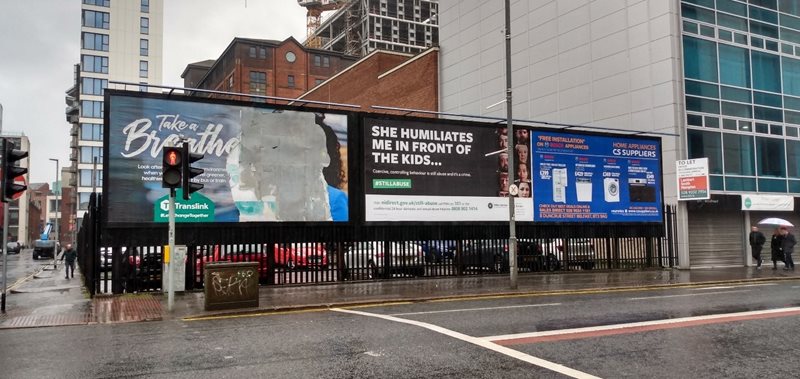
5.3 Gable mounted advertisements
Description
5.3.1 Large scale poster panels (generally 48 sheet displays) can be a common feature on gables of buildings in those predominantly commercial parts of the city and may offer benefits, such as screening an untidy elevation.
Potential impact
5.3.2 Care however needs to be taken with such proposals to ensure they are not over dominant and relate well to the building on which they are proposed to be positioned. Tiers of advertisements affecting the gable or flank wall of a building should be avoided as they can have a significant detrimental impact over long distance views, whilst more local views can appear cluttered.
Gable Mounted Advertisements – Design Guidance
- Design, form, size, proportions and siting of a gable mounted advertisement should be sympathetic to the host building to which it is to be attached.
- Should generally be located above ground floor level on the gable and be symmetrical with the wall on which it is to be positioned.
- Interesting features such as architectural detailing should not be obscured, damaged or destroyed.
- Windows should not be covered, and the normal functioning of the building should not be adversely affected.
5.4 Shroud advertisements
Description
5.4.1 Shroud advertisement displays are known by a variety of names such as meshes, wraparounds or blow–up signs. While they range in size, they are generally large-scale and can cover the full elevation of a building. They can help to shield unsightly construction work and can even be used to present visuals of what a building/development will look like when alterations, renovations or building works have been completed.
Potential impact
5.4.2 Due to their scale and size, shroud advertisements have the potential to seriously conflict with the visual amenity of buildings upon which they are affixed and the area in which a building is sited. Listed buildings, Conservation Areas and ATCs are particularly sensitive to shroud advertisements as they can be overwhelming and have a detrimental impact on the character and appearance of buildings and areas.
5.4.3 Accordingly, proposals for this type of advertisement are only likely to be acceptable primarily in commercial areas, where they are to be attached to scaffolding surrounding a building or development site and where a contract has been drawn up for the building or renovation works.
Shroud Advertisements – Design Guidance
- Encouraged that any netting/shrouds on building scaffolding covering an entire elevation of a building depicts a true 1:1 image of the completed building which is undergoing construction work.
- Any advertisements on the shroud should cover no more than 20 per cent of the shroud on each elevation and should not be fragmented.
- Should not exceed the height and length of the completed building.
- Proposed duration of works and shroud presence should be confirmed at application stage.
5.5 Commercial/shopfront advertisements
Description
5.5.1 Signs and advertisements on commercial premises are important in announcing the presence of a business on the street and in directing customers to that location and can assist the vibrancy of our city and town centres and other commercial areas. The most common signs on commercial premises are fascia signs and projecting signs, either box or hanging. When sympathetically sited and designed they can contribute positively to the distinctive visual amenity of an area by giving a sense of quality and permanence.
5.5.2 Blinds, awnings and canopies can also form a key component of commercial/shopfront signage. Originally the function of blinds was to protect perishable goods from deterioration due to strong sunlight, however today blinds, awnings and canopies are increasingly used to provide additional advertising.
5.5.3 Where commercial premises occupy the upper floors of buildings the need to advertise their whereabouts can be important to their viability. High level advertisements/signs generally relate to those vertical or horizontal signs on the walls of tall, single use buildings such as hotels.
5.5.4 Coverings that obscure glazed areas at ground floor level, undermining good placemaking and urban design principles that promote active frontages, should be avoided.
Potential impact
5.5.5 The design of fascia signs and projecting signs should always complement and respect the design of the shopfront/host building and surrounding context in a positive manner. An excessive number of signs, or those which are too large, can dramatically affect the premises on which they are sited and have an adverse impact on the general character of the area.
Fascia Signs – Design Guidance
- Fascia signs should be appropriately sited and of a size and design that is sympathetic with the shopfront, the façade of the building and any detailing thereon.
- Where there is an original fascia, the sign should make use of this with generally no advertising at sub-fascia level or on pilasters or columns.
- Where a new commercial building is proposed, the location of fascia signage should be integrated into the overall design.
- On older and more traditionally styled buildings, painted signs or non-illuminated letters are preferable to panels or other types of display.
- Internal illumination should preferably be in the form of individually backlit letters (halo illumination) and the use of internally illuminated lightboxes avoided.
- Where external illumination is proposed, trough lighting is preferred. The trough should extend over the whole fascia and be painted to integrate it into the whole display.
Image 4: Fascia signs
Image showing appropriately sited fascia signs on Arthur Street that complement and respect the host building in terms of their overall design, proportions and detailing.
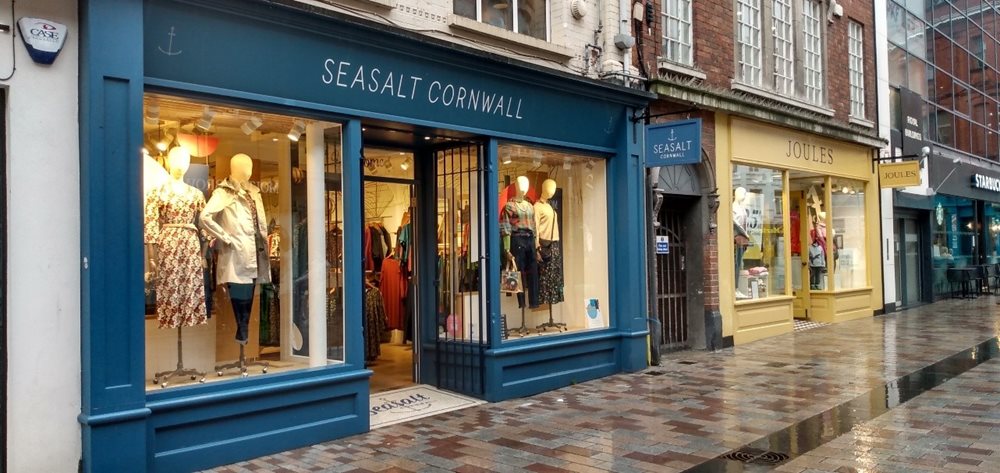
Projecting Signs – Design Guidance
- Projecting signs should be sympathetic to the design of the building where they are to be displayed and respect fascia signage.
- Box signs should be located at fascia level and are generally best situated at the end of the fascia.
- Hanging signs may be acceptable at first floor level and are generally best situated in a central position between windows.
- To reduce visual clutter, a projecting sign will generally only be acceptable where there is no other projecting advertisement such as a canopy, awning, flag or horizontal banner.
- Internal illumination should preferably be in the form of individually backlit letters (halo illumination).
- Where external illumination is proposed, trough lighting is preferred with the trough painted out.
- Illuminated projecting signs are generally unacceptable immediately adjacent to a neighbouring residential property.
- Projecting signs should generally project no more than 1 metre including fixings, with a maximum end width of no more than 0.1m in the case of a box sign.
- In the interests of public safety, projecting signs should be a minimum of 2.25m above ground level.
Images 5 to 7: Projecting signs
Projecting signs are generally located at ground floor near the business entrance but can be placed at first floor level so long as they are sympathetic to the host building.



5.5.56 Blinds, awnings and canopies that are well designed can improve the attractiveness of a building or street. Poorly designed or prominently located blinds or canopies displaying advertising can however detract from the appearance of buildings, the surrounding neighbourhood, and can result in clutter. They are particularly obtrusive when located above windows on upper floors and should be avoided in these locations.
Blinds, Awnings and Canopies – Design Guidance
- Blinds, awnings and canopies should be retractable, made from non-reflective material and be designed to integrate with the appearance and construction of the commercial premises / shopfront as a whole.
- In the interests of public safety, blinds, awnings and canopies should be a minimum of 2.25m above ground level.
Image 8: Blinds, awnings and canopies
Blinds, awnings and canopies can improve the attractiveness of a building, particularly where they are sensitive to façade details such as window openings and fascia depths.
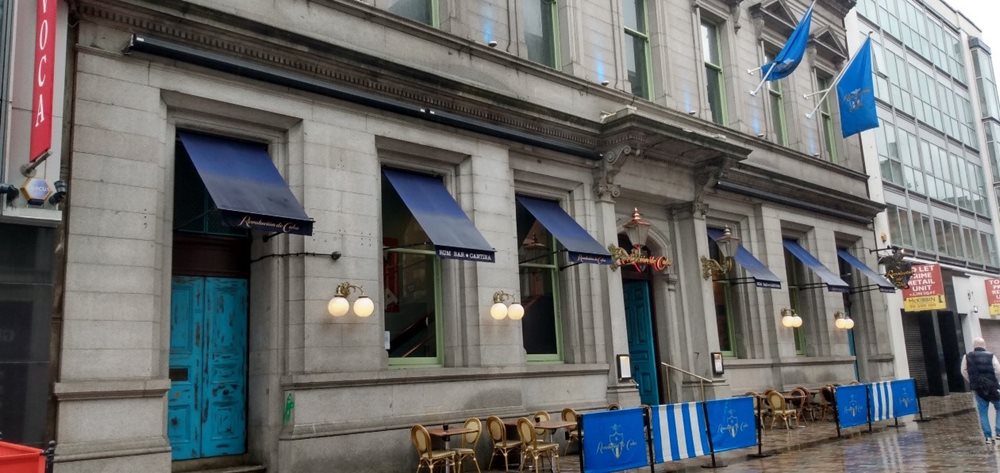
5.5.7 If not treated with great sensitivity, high level advertisements/signage have the potential to give the appearance of clutter within the local street scene and be obtrusive and dominant over long distances particularly when located on roofs. Great care needs to be taken in considering how this can be achieved without the exterior of the building appearing cluttered. Fascia signs, panel style signs, canopies, flags and banners are generally out of place on upper floors.
High Level Advertisements/Signage – Design Guidance
- High level signs will generally only be appropriate where they relate to the scale and primary use of the host building.
- They should be designed to be read as part of the building and should not detract from any architectural feature.
- They should not project above the eaves or parapet of the host building.
- They should have only the lettering illuminated, preferably in the form of back lighting/halo illumination and restricted to sign lettering and logo only.
- On upper floors, advertising/signage should be printed or etched onto the glass or on to internal window blinds. As an alternative, individual letters rather than an advertisement panel may be suspended behind the glass.
Images 9 and 10: High Level Advertisements/signage
Examples of high level signage which relate to the primary use of the property with their design reflecting that of the host building.
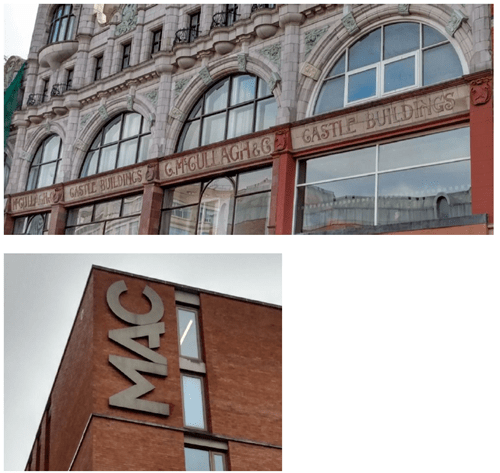
5.5.8 In predominantly residential areas, where offices occupy part or all of a former residential property, it is essential that advertising remains unobtrusive in order that the residential amenity of the area is not prejudiced. Even in situations where offices occupy a row of former residential properties it will generally still be important to retain the overall residential appearance of the area. A more flexible approach will however be considered in those areas where, through ongoing change, surroundings have become mainly commercial.
Signage on Former Residential Properties – Design Guidance
- The advertisement of offices in former residential properties should be by means of nameplates. These should be of metal construction or other suitable materials and should be fixed to the doorway pilaster or else to masonry beside the front door.
- Painted or etched lettering on a front window will also generally be acceptable.
Image 11: Signage on former residential properties
Example of a former residential property which now incorporates a commercial premise at ground floor. Here signage includes nameplates adjacent to the building entrance which have been sensitively combined with a modest downlit fascia sign.
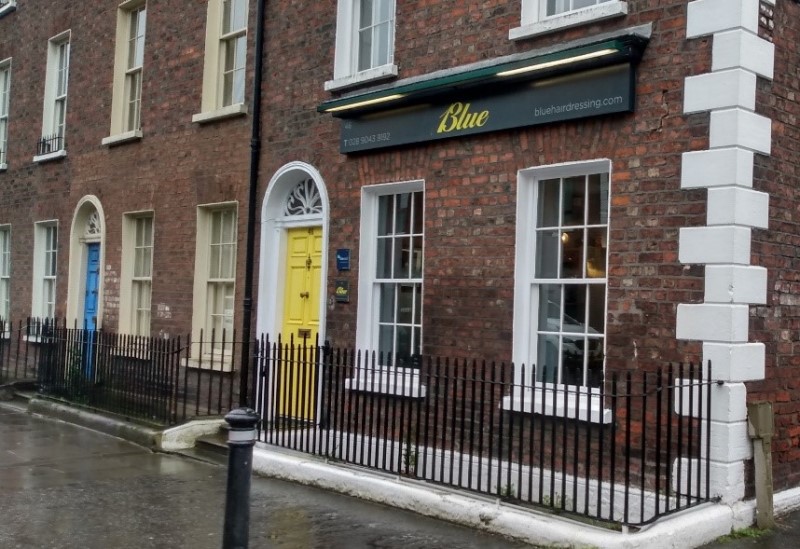
5.6 Retail and business park signage
Description
5.6.1 Retail and business park signage includes signage placed on the building or group of buildings, freestanding signage in proximity of buildings and/or advance signage located close to the entrance to the retail/business park.
Potential impact
5.6.2 The uncoordinated display of advance advertisements or ad hoc directional signs to individual businesses within retail/business parks, which bear no direct relationship to the building, land or structure on which it is displayed can be confusing, untidy and detrimental to the appearance of an area.
5.6.3 There is great potential for all advertising associated with retail or business parks to be undertaken in a planned and co-ordinated manner. Ideally the fascia signs for individual premises should form an integral part of the building, while a single carefully designed directory board located at the entrance to the park or in other acceptable locations can avoid a proliferation of advance signs.
Retail and Business Park Signage – Design Guidance
- All new buildings in a retail or business park should incorporate a signing zone as part of the design.
- Fascia and projecting signs should be in scale with the host building and surrounding buildings and be consistent across the whole unit.
- Advance signage should be provided in the form of a combined directory board within a proposed or existing landscaped area designed and integrated as one scheme.
- Signage should be located so as not to interfere with or obstruct sightlines.
5.7 Filling station/forecourt signage
Description
5.7.1 Filling station/forecourt signage generally comprises a combination of a canopy, a pole/pylon and shop fascia signage together with a number of smaller forecourt signs.
Potential impact
5.7.2 Given the range of signs involved, there is the potential for their cumulative effect to result in clutter. To help prevent this a co-ordinated approach should be taken when bringing forward proposals, particularly where existing signage is being replaced. Particular care is needed in assessing proposals for illuminated advertisements at filling stations located adjacent to or near residential properties.
Filling Station/Forecourt Signage – Design Guidance
- All signs should be in scale with their surroundings and not detract from the amenity of the surrounding area.
- Illumination should be restricted to sign lettering and logo.
- Freestanding signs should be located so as not to interfere with or obstruct sightlines and incorporate a minimum distance of 5.0m between signs.
- Avoid sensitive areas where they could result in a competing focus including near listed buildings, within conservations areas, ATCs and predominantly residential areas.
Image 12: Filling station/forecourt signage
Recently constructed petrol filling station/supermarket where consideration has been given to the degree of illumination associated with the freestanding sign and the building itself.
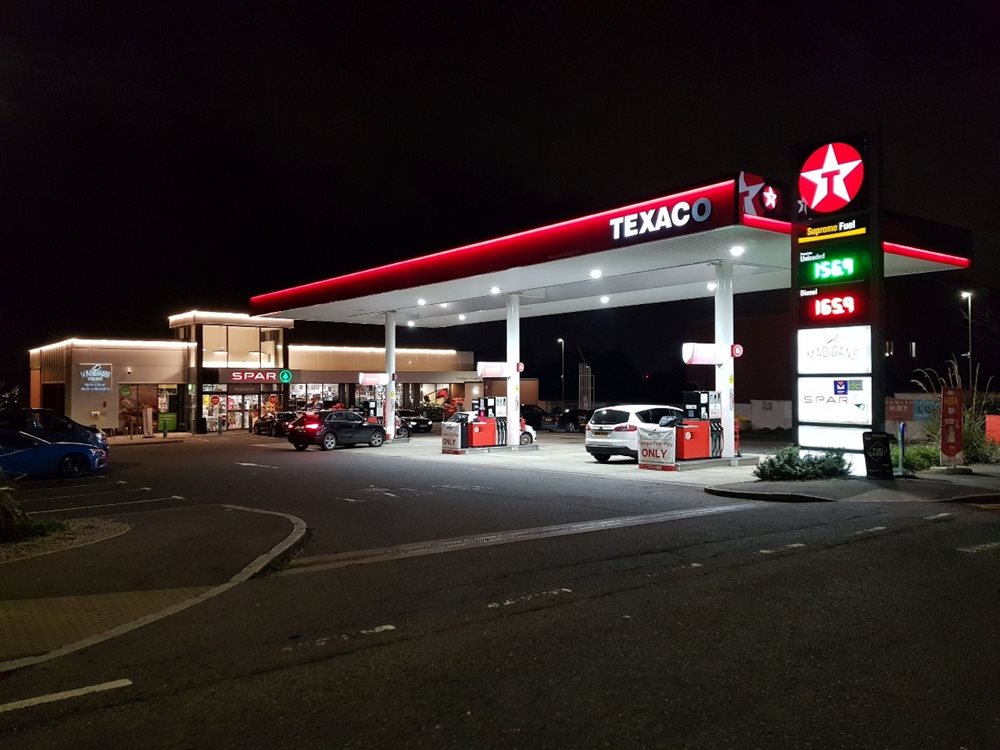
5.8 Pylon and pole mounted signage
Description
5.8.1 Pylon and pole mounted signs are a common feature at petrol filling stations and are increasingly found in association with drive-through restaurants, supermarkets, retail warehousing, retail parks and car showrooms.
Potential impact
5.8.2 The height, size and levels of illumination of pylon and pole mounted signs can result in visual intrusion within the locality where they are situated. They can be extremely dominant over long distances and detract not only from the character and appearance of the area in which they are sited, but also that of the area from which they are viewed. In addition, where they are proposed close to residential properties, they can be detrimental to amenities enjoyed by residents.
Pylon and Pole Mounted Signage – Design Guidance
- Should be in scale with their surroundings and should not significantly exceed surrounding building heights.
- Should not detract from the visual amenity or character of the surrounding area.
- Should not be sited adjacent to, and wherever possible should not directly face residential properties.
- Illumination should generally be restricted to the sign lettering and logo
5.9 Digital advertisements
Description
5.9.1 Digital advertisements (sometimes referred to as digital screens or digital billboards) often project advertisements in video format but can also show a still image or be programmed to cycle through a series of still images. As a relatively new method of advertising which was already common in many shopping centres and transport hubs, digital advertising is increasingly being developed for outdoor use and have the advantage of being controlled remotely.
5.9.2 Digital advertisements can vary in size, are generally illuminated and can be affixed externally to buildings, integrated into components within the public realm such as bus shelters or take the form of stand-alone elements such as the digital ‘kiosks’ that have in more recent years become a common feature within the public realm of the city centre.
Potential impact
5.9.3 Digital billboards can be an effective form of advertising and despite being more costly compared to traditional billboards (at least initially), there has been increasing pressure for the installation of various types of digital advertisements across the city, specifically with regards to stand-alone kiosks. However, by their very design and siting, digital advertisements can be visually prominent and ‘attention focused’ by way of their illumination and sense of movement particularly when they are large in size and in close proximity to each other.
Digital Advertisements – Design Guidance
- More suitable to predominantly commercial areas, industrial areas or along transport corridors and areas with larger buildings where signage can be integrated more effectively into architecture.
- Avoid siting in sensitive areas including near listed buildings, within conservations areas/ATCs, predominantly residential areas and where they could become the most prominent feature of the streetscene. Consideration should also be given to orientation and position to the carriageway and proximity to traffic signals and hazards.
- Assess potential impact of lighting levels including degree of luminosity, brightness and operational hours, particularly during times of reduced daylight hours.
- Consideration given to elements such as message duration, transitions and sequencing.
- Consideration should be given to the cumulative effect of digital advertisements when read with other advertisements and signs which would result in clutter to the streetscape.
Images 13 and 14: Digital advertisements
More recent signage interventions within the city centre include digital advertisements in the form of stand-alone kiosks providing users with a range of information with mobile charging capability.
5.10 Small format outdoor advertisements
Description
5.10.1 Locations may exist where small format outdoor advertisement displays, including adverts affixed to street furniture, are appropriate, such as in commercial areas. However, such displays will need to be in keeping with the design and layout of the public realm and ensure that impact on the character of the area and on pedestrian safety is not compromised.
Potential impact
5.10.2 Care needs to be taken where such advertising is proposed in areas of historic interest where important views and vistas or the setting of designed landscapes or listed buildings are present. Particular care should be taken when proposing advertising in residential areas.
Small Format Outdoor Advertisements – Design Guidance
- More suitable in areas of commercial character and within areas that are subject to comprehensive redevelopment proposals that comprise public realm works.
- Can be considered on the following items of street furniture - bus and tram shelters, bicycle lockers, parking ticket machines and litter bins.
- Avoid sensitive areas where they could result in a competing focus including near listed buildings, within conservations areas/ATCs and predominantly residential areas.
Image 15: Small format outdoor advertisements
Example of advertisements incorporated into the design of a bus shelter within the city centre core where consideration has been given so as not to result in a competing focus to surrounding heritage assets.
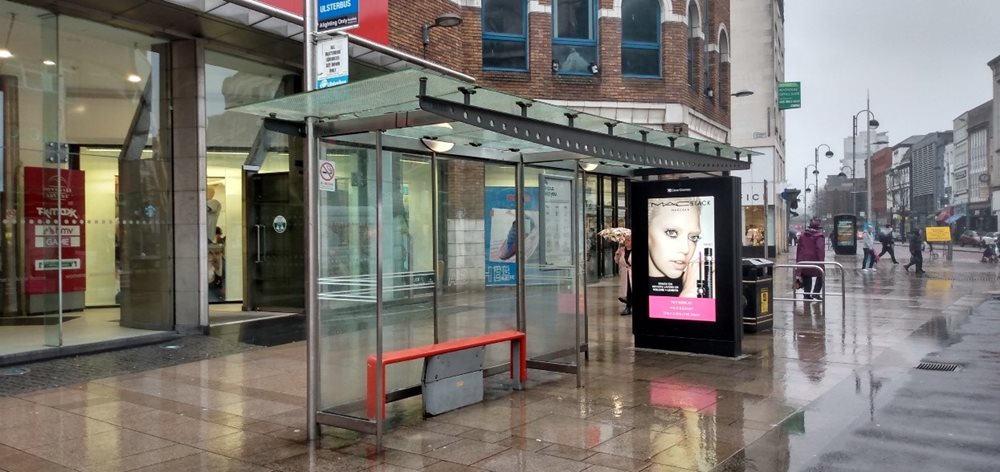
5.11 Estate agent boards
Description
5.11.1 Estate agent boards are signs that are placed outside of a sale or rental property and are usually hung from railings or affixed to posts or walls generally close to the property entrance.
Potential impact
5.11.2 Estate agent boards are an inexpensive marketing tool when compared to newspaper and magazine advertising and an effective manner of informing passing trade which properties are currently available. However, unless properly managed, the unregulated display of estate agent boards can quickly proliferate and result in undue clutter within our streets. Many view these boards as largely redundant in today’s digital age and visually a blight on our urban landscape particularly if displayed for longer periods than necessary.
5.11.3 Estate agent boards of a certain number and size can be erected on properties without the benefit of advertisement consent. Typically, only one non-illuminated advertisement, of specified dimensions and height per property, has deemed consent and should be removed no later than 14 days after completion of the sale or granting of the tenancy.
5.11.4 Belfast City Council has requested the Department for Infrastructure (DfI) to grant a direction under Section 6 of The Planning (Control of Advertisements) Regulations (Northern Ireland) 2015 for the removal of deemed consent for the display of letting boards relating to residential properties, in the following Conservation Areas and Areas of Townscape Character:
- Holyland Area of Townscape Character.
- Stranmillis Village Area of Townscape Character.
- Malone Conservation Sub-Area B: Eglantine/Wellesley/Wellington.
- Botanic Avenue Area of Townscape Character.
- Queens Conservation Area; and
- Rugby Road Area of Townscape Character.
5.11.5 Deemed consent for the display of estate agent boards in these areas does not therefore apply. Advertisement consent is therefore required to display a board in these areas; however, the council will strongly resist granting consent due to the impact that boards would have on visual amenity.
5.12 Flyposting
Description
5.12.1 While there is no formal definition of fly-posting, this activity is generally taken to be the display of advertising material on buildings and street furniture without the owner’s consent. Fly-posting can generally fall into three camps, each with particular characteristics and problems of control which include, adverts linked to local events often photocopies/stickers displayed in large numbers (attached to lampposts, railings, street furniture and buildings), larger posters advertising products put up by professional poster companies and posters displayed by pressure groups or political parties.
Potential impact
5.12.2 Fly-posting occurs in most locations but can be particularly prevalent and prominent within built-up areas, can be unsightly and often symptomatic of urban decay. Given the increasing emphasis placed on the quality of life and the built and natural environment, an increasing emphasis has also been placed on proactively addressing this issue across the city. This is particularly so in more prominent and heavily trafficked areas where a proliferation of such activity can have a negative impact on the street scene.
6 Information required for applications
6.1 Submitting an application for advertisement consent
6.1.1 In the first instance, all developments should be discussed with the council to determine whether the development is deemed consent or will require advertisement consent.
6.1.2 In determining and assessing the degree and impact of any advertisement or sign on amenity, heritage and road safety, it is important that the applicant provides adequate information in support of an application. The information includes that which is required on the council’s advertising consent application Form A1.
Checklist – Information to Accompany An Application
- Drawings - scale drawing(s) outlining the dimensions of the advertisement/sign and the building on which it is to be located. Should clearly show its position on the land or building in question i.e. its height and width, its height above ground level and the degree of projection from the building. If proposed on a listed building, drawings should include a detail section to illustrate profile and fixing method in relation to existing features.
- Contextual information – drawings/elevations/photos of the front of the building or site upon which the advertisement/sign is to be placed alongside drawings/elevations/photos of neighbouring buildings.
- Type – confirmation of the type and position of advertisement i.e. size, colour and style of the sign including the design of lettering or emblem to be adopted, materials and fixings.
- Illumination – confirmation if the sign is to be illuminated as well as the type and colour of illumination and if static or intermittent. Confirmation should also be provided of default colour setting if changeable with warm white preferable for listed buildings. Reference should be made to the Historic Environment Division’s guide to consulting on development management applications for further information.
- Fee – appropriate fee to be made payable to the council.
6.1.3 Depending on individual circumstances, development requiring advertisement consent may be required to provide additional information to that listed above, as outlined by the council.
7 Enforcement of advertisement control
7.1 Overview
7.1.1 Section 130 of the Planning Act (Northern Ireland) 2011 sets out the legislative requirements for the control of advertisements. Section 130 (1) states that provision must be made by regulations to restrict or regulate the display of advertisements. The subsequent regulations are The Planning (Control of Advertisements) Regulations (Northern Ireland) 2015. Article 4 of these regulations state that no advertisements can be displayed unless consent for its display has been granted on an application (application for advertisement consent) or adverts are permitted within the parameters of deemed consent as set in Article 5 of these advertisement regulations.
7.1.2 Section 175 (2) of The Planning Act (Northern Ireland) 2011 states that any person who displays an advertisement in contravention of the Regulations is guilty of an offence and on summary conviction is liable to a fine from the courts with the potential for further daily fines in the case of a continuing offence[Footnote 3]. Furthermore, Section 175 (3) (a) and (b) provides that a person shall be deemed to display an advertisement where it is displayed on land of which he is the owner or occupier, or it gives publicity to his goods, trade, business or other concerns.
7.1.3 In effect, this means that the council may in such cases seek to prosecute:
(a) the person, business or company responsible for the advertisement.
(b) the landowner or the occupier of the land.
(c) the person, business or company being advertised; or
(d) any combination of these[Footnote 4].
7.1.4 The Planning Act also makes it clear that in the case of (b) or (c) above, a person shall not be guilty of an offence if he can prove that the unauthorised advertisement was displayed without his knowledge or consent. The council will normally pursue court action for unauthorised advertisements which it considers unacceptable.
7.1.5 It should be noted that where an application for advertisement consent is submitted following a warning letter, this of itself will not prevent the council from pursuing prosecution.
7.1.6 Furthermore, certain situations may arise where the council considers it expedient to move straight to prosecution proceedings without warning.
Footnotes
[Footnote 1] The Planning (Control of Advertisements) Regulations (Northern Ireland) 2015 Schedule 2.
[Footnote 2] The Planning (Control of Advertisements) Regulations (Northern Ireland) 2015 Schedule 3. It should also be noted that the Regulations provide the council with the power to make a direction withdrawing ”deemed consent”.
[Footnote 3] The maximum fine is currently £1,000 with a daily maximum for a continuing offence of £100. The Department is however bringing forward legislation that proposes an increase in the maximum fine to £2,500 and the daily maximum fine to £250.
[Footnote 4] There is no requirement where enforcement is taken that this will be against all those with an interest in the land or otherwise involved in the display of an unauthorised advertisement.
